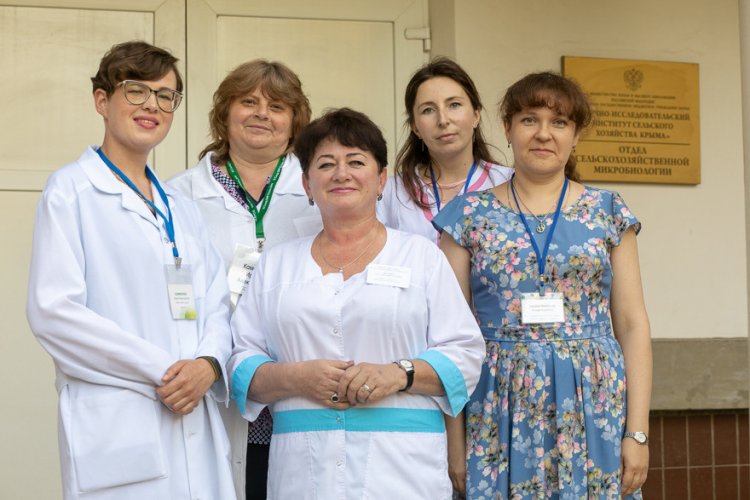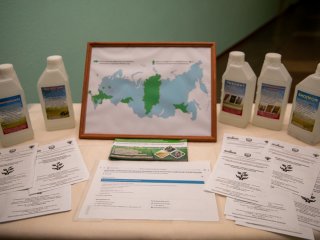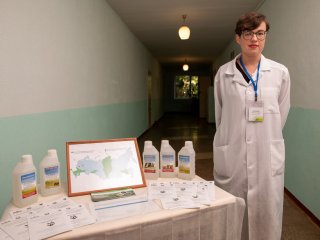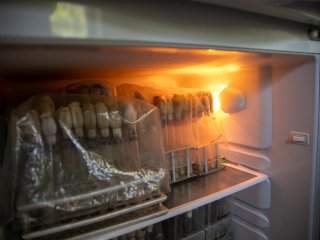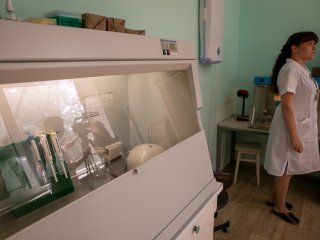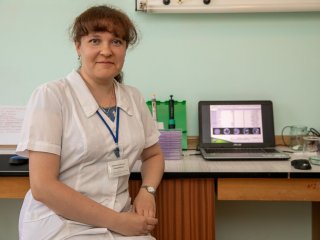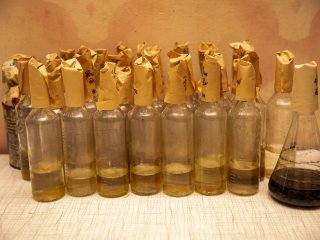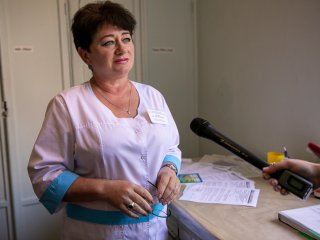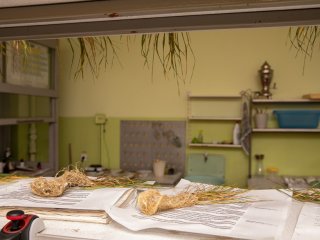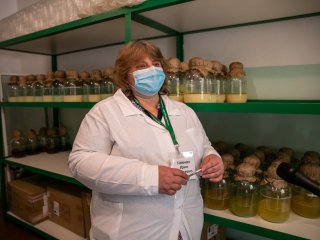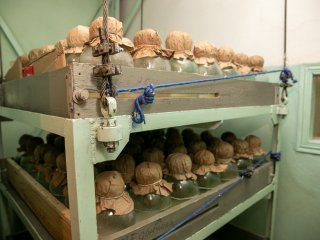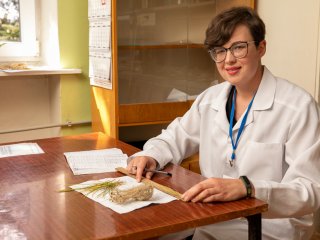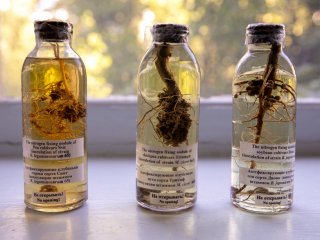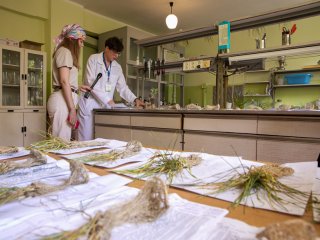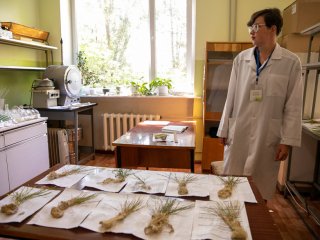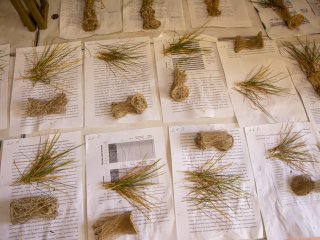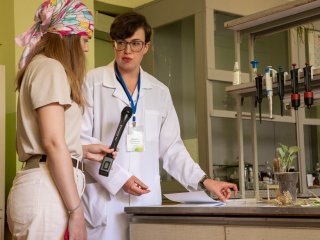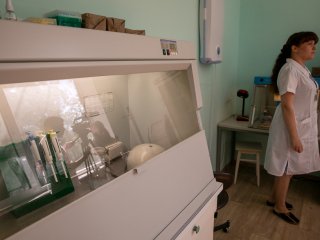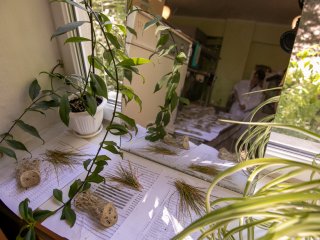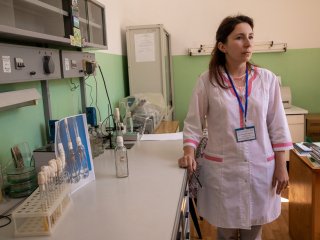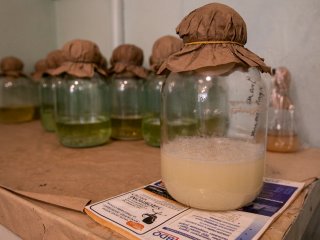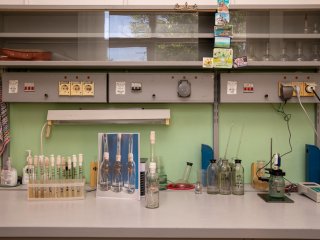On June 12, as part of the press tour to the Republic of Crimea, the Scientific Russia portal visited the Agricultural Microbiology Department at the Agricultural Research Institute of Crimea. The main objectives of the department is to find and produce new strains of microorganisms, produce biological products derived from microorganisms isolated, address issues to enable biological destruction of plant residues with bioherbicides, and develop other promising areas of agricultural microbiology. The staff of the department consists of 29 research officers, including 2 Doctors and 6 Candidates of biological and agricultural sciences. Over its history, the department produced over 600 scientific articles, monographs, author’s certificates, patents, and other works.
Nina Nikolaevna Klimenko, Candidate of Agricultural Sciences, research officer of the Plant-Microbe Interaction Laboratory (phosphate-mobilizing bacteria), spoke of ongoing experiments with phosphate mobilization with plant-microbe compounds. “There is not enough phosphorus in the soil. Phosphate compounds that plants need for normal growth and development are bound. It’s calcium compounds in alkaline soils, and aluminum compounds in acid soils. That makes it hard for plants to access them. To address that, we have to use microbial preparations or find and select them for a particular property,” Nina Klimenko said.
Comments from Nina Nikolaevna Klimenko, Candidate of Agricultural Sciences, research officer of the Plant-Microbe Interaction Laboratory
Svetlana Vitalievna Didovich, Candidate of Agricultural Sciences, leading research officer of the Plant-Microbe Interaction Laboratory (bioherbicides to control the quarantine ragweed), told Scientific Russia of the issue of biological nitrogen in farming. “Grain legume and cultivated herbs are species ensuring nitrogen balance in the soil. Their share is only 3%, which is 3.4 million hectares, while in a science-based system it should be up to 20%. Legumes have a unique property – in symbiosis with tubercle bacteria, they form nitrogen-fixing tubercles, wherein the nitrogen fixation process occurs. There are 80,000 tons of nitrogen in the air over every hectare of land. The process of nitrogen-fixation occurs in tubercles formed by a legume plant (fixation of molecular atmospheric nitrogen),” Svetlana Didovich clarified.
Comments from Svetlana Vitalievna Didovich, Candidate of Agricultural Sciences, leading research officer of the Plant-Microbe Interaction Laboratory
Scientists of the Laboratory of Molecular and Cellular Biology investigate alternative ways to improve soil fertility within various farming systems. Anna Yurievna Yegovtseva, research officer of the Laboratory of Molecular and Cellular Biology (alternative farming and associative bacteria), spoke in detail about introduction of microbial preparations to improve vegetative activity in fields. “We investigate changes in microbiome in the rhizosphere of plants: how they affect the physical state of plants and the structure of microbial diversity of agricultural crops: winter wheat, barley, flax, sorghum, and pea. We are looking for and research microorganisms that are highly associative with the plant, to add to the collection of our department. Every species requires specific selection of strains to fit biological characteristics of the plant,” Anna Yegovtseva pointed out.
Comment from Anna Yurievna Yegovtseva, research officer of the Laboratory of Molecular and Cellular Biology
Anastasia Vladimirovna Kryzhko, leading research officer of the Laboratory of Molecular Genetics, Proteomics and Bioinformatics in Agriculture (biomethod in pest control and genome research in agriculture), showed what a bacterium that can kill harmful insects such as Colorado potato beetle looks like. “This bacterium has certain pathogenic factors that consist of spores and crystals. Based on the data obtained, we develop processes to cultivate the bacterium so that we can produce laboratory procedures for preparative forms.”
Comment from Anastasia Vladimirovna Kryzhko, leading research officer of the Laboratory of Molecular Genetics, Proteomics and Bioinformatics in Agriculture
Irina Alekseevna Kameneva, Candidate of Agricultural Sciences, leading research officer of the Laboratory of Physiology and Ecology of Microorganisms, spoke of destruction of cellulose and production of microbial preparations in the agricultural microbiology division. “The outcome of our work today is microbial preparations for all leguminous plants we grow. Our main focus is grain crops. It is most important to have both the preparation and the preparative form. The main priority today is liquid preparations. They consist of the microorganism culture itself. The cellulosolytic package is a set of microbial preparations to destroy plant residue, which is applied at the rate of 1,000 cm3 per hectare. The amount of the working solution depends on the capabilities of agricultural companies. The preparation is applied to straw or stubble and then buried in the ground immediately,” Irina Kameneva said.
Comments from Irina Alekseevna Kameneva, Candidate of Agricultural Sciences, leading research officer of the Laboratory of Physiology and Ecology of Microorganisms
Even now, many years of experience in creating biological preparations for plants enable increased yield, improved quality of produce and soil fertility recovery, and preservation of the environment through application of live products of microbial culture.
This material was prepared with the support from the Ministry of Science and Higher Education and the Russian Academy of Sciences.
